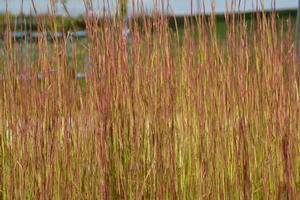New Moon Nurseries
Andropogon virginicus
Broom sedge
Native to North America
FIRST IMPRESSIONS: Andropogon virgincus is a clump forming perennial grass that grows in narrow upright tufts. Leaves are medium green and erect. Foliage turns a lovely golden orange in fall and winter. On late winter afternoons, a field of Broom Sedge is quite a spectacle with glowing coppery foliage and silvery hairs that refract the sunlight. This grass prospers in sunny sites with disturbed or poor infertile soils.
HABITAT & HARDINESS: This pioneer species is common in the eastern and southeastern United States and as far north as the Great Lakes. It barely extends into the Midwestern prairie states.
Andropogon virginicus is indigenous to abandoned fields, early and mid-successional prairies, disturbed roadsides, railroad rights-of-ways, pastures, exhausted mined land, and barren waste areas.
Hardy from USDA Zones 5-8.
PLANT DESCRIPTION: Andropogon virginicus is a slender bunch grass with an upright or vase shaped habit and dense fibrous roots.
Leaves are linear and about 12” long and ¼” wide. The leaf base or sheath folds around the stem. Straw colored remnants of old leaves and stems are clustered at the base of the plant.
Culms are topped with greenish panicles of bristle tipped spikelets in late summer and early fall. Tufts of silky white hairs cover the flowers and seed heads and give a feathery appearance. In winter, foliage and seed heads develop a pleasing golden orange color.
Plants grow 2-3’ or taller with 2-3’ spread.
CULTURAL & MAINTENANCE NEEDS: Andropogon virginicus is a pioneer soil stabilizing grass. Plants need little maintenance except to be cut or burned to the ground in late winter.
This grass tolerate drought, infertile soils, seasonal flooding and adapt to sites disturbed by grading, construction or overgrazing.
Foliage is low in nutrients and generally unpalatable to deer and livestock unless tender new growth is present.
LANDSCAPE USES: This is a useful grass for Erosion Control, Rain Gardens and Stormwater Management. Andropogon virginicus provides Fall Color and Winter Interest. Plants are appropriate for Water Wise Landscapes, Meadows, Roadsides and Restoration Projects.
COMPANION & UNDERSTUDY PLANTS: Try pairing with Asclepias tuberosa, Rudbeckia fulgida var. fulgida, and Vernonia glauca.
Schizachyrium scoparium is similar in appearance and cultural needs and can be substituted if needed.
TRIVIA: Andropogon virginicus has two or more stalked seed clusters per branch, a straight awn or bristle on the spikelet, yellowish color at the base of the stem and gold or orange color on mature plants. Its look-alike cousin, Schizachyrium scoparium, has a single cluster of seed on a branch, twisted or bent awns, lavender color at the stem base and rusty color with purple highlights on mature plants.
Andropogon virginicus is an introduced invasive species in California, Hawaii, Japan and Australia. It is called “Whiskey Grass” in Australia because it escaped after being used as a packing material for bottles of American whiskey.
Many farmers and ranchers consider this species to be an undesirable indicator of poor soil. This grass is allelopathic. It excretes chemicals that inhibit growth of shrubs and some desirable forage plants. This resistance to invasion allows Andropogon virginicus to maintain itself in large populations.
Provides cover and nesting material for Quail and other birds.
Height:
2-3 ftSpread:
2-3 ftSpacing:
36-48 inUSDA Hardiness Zone:
5-8Bloom Color:
Green, TanAndropogon virginicus Characteristics
Attributes
- Naturalizing
- Dried Flower
Exposure
- Full Sun
Flowering Months
- September
Grass Season
- Warm Season Grass
Salt Tolerance
- High
Soil Moisture Preference
- Moist to Dry
Interesting Notes:
For more information on this plant, visit the USDA PLANTS Database: http://plants.usda.gov/java/profile?symbol=ANVI2
